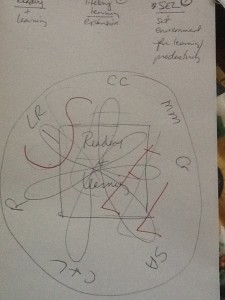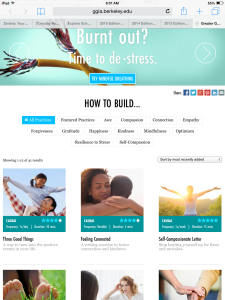I’ve incorporated lifelong learning practices for 3 years into my college reading course and each time, we’ve seen statistically significant changes in lifelong learning dimensions (ELLI) for our students (Shaffer, Eshbach, & Santiago-Blay, 2015) – now after attending the social-emotional learning (SEL) institute this summer at Berkeley, I want to also incorporate SEL… but how?
As I started my musings over the design, it seemed to make sense for SEL to be sort of the swimming pool we jump into – the environment for learning that we create in class… Then imagine a water aerobics class taking place inside the pool – that represents the work we do to build up reading/learning skills… and finally, the changes we see in our bodies – stronger muscles and greater endurance – are the lifelong learning qualities that we’ll develop over time.
Here is the rough sketch as I envision this…
 So I want to start each session creating the environment for learning – with a SEL practice from http://ggia.berkeley.edu/ Then on the first day of the week, we’ll work on reading/learning skills… On the second day, we’ll work on lifelong learning skills…
So I want to start each session creating the environment for learning – with a SEL practice from http://ggia.berkeley.edu/ Then on the first day of the week, we’ll work on reading/learning skills… On the second day, we’ll work on lifelong learning skills…
This is the first year this course has NOT been paired with a content course. It became too challenging logistically. I lament this, because that model gave us real content and shared milestones and challenges (projects, exams, etc.) upon which to apply what we were learning. The shared course gave us the opportunity to talk about concrete, shared experiences… Students saw the relevance and it also gave them extra time to work on specific classes without adding the burden of new material/assignments from the reading course. On a related note …we are doing a pilot with Civitas Learning with predictive modeling and our campus data – one factor that arose from our own data as a predictive factor was the number of different courses that students take. This stands to reason … the more complex and diverse a student’s schedule becomes, the more challenging it is… For students who struggle with reading, this represents perhaps the greatest challenge! So pairing courses – a support course in which students work on a content course – provides a way for students to gain credits (3 + 3) without adding the burden of learning completely separate content…. So let’s see how this standalone course works. I am dubious about it..How much transfer of learning will we lose without a direct course to which we apply the learning?
So what to use in this standalone course for material upon which to apply the reading strategies?
I’m thinking to use a wide reading approach…research articles on SEL, ELLI, Mindset, and readings in their areas of interest/major, and also a textbook from a current class.
Which SEL strategies to use?
This first time through, I’ll rely heavily on these from http://ggia.berkeley.edu/
and practices from Contemplative Practices in Higher Education: Powerful Methods to Transform Teaching & Learning by Barbezat and Bush (Jossey-Bass, 2014).
What will ELLI integration look like this time?
Start with the pre-test and reflection – gathering stories of what has been and what IS…
I will re-think the order in which we consider each dimension – ELLI’s 7 dimensions of lifelong learning: Meaning-Making, Changing & Learning, Learning Relationships, Resilience, Creativity, Strategic Awareness, Critical Curiosity
I used to start with resilience, b/c this was the area where most students struggle, and we certainly want to build this up right away… but it seems a negative space to begin… so I am thinking this time to start with meaning-making… why are you in college? What do you hope the meaning of your life will be? What is the purpose of your going to college? How can entering into the college experience more fully, help you to change and grow? So Meaning-Making flows into Changing & Learning (Mindset!!!) into Learning Relationship (SEL community building!!), Resilience (right after the first round of exams!), Creativity (imagining different outcomes), Strategic Awareness (planning strategically for success), and Critical Curiosity – a chance to revisit who we are as learners, and what drives a meaningful college experience! I like this!
I think it is time for a table to start to put topics, readings, and strategies into place… then edit edit edit – I PROMISE myself, NOT to overload things… always too much I want to do… and that doesn’t work… Stay tuned….
References
Deakin Crick, R., Broadfoot, P., & Claxton, G. (2004). Developing an Effective Lifelong Learning Inventory: The ELLI project. Assessment in Education, 11, 247-272. doi:10.1080/0969594042000304582
Deakin Crick, R., & Yu, G. (2008). Assessing learning dispositions: Is the Effective LifelongLearning Inventory valid and reliable as a measurement tool? Educational Research, 50, 387-402. doi:10.1080/00131880802499886
Shaffer, S.C., Eshbach, B.E., & Santiago-Blay, J.A.; (Fall 2015). A dual approach to fostering under-prepared student success: Focusing on doing and becoming. InSight: A Journal of Scholarly Teaching; Vol. 10; The Center for Excellence in Teaching and Learning (CETL) Park University. Parkville, MO.


Suzanne, I agree that the design should first focus on the Meaning-Making dimension. I think focusing too soon on Resilience sends a message that ‘this is hard and you may not like it but there are ways to get through this ugliness’. Identifying their own purpose and meaning seems to make a lot of sense. Perhaps Resilience is best brought on later, perhaps even as the first struggles begin and at that point, it’s brought in by laying it in the context of their meaning for the experience.
Hi Matt,
Yes, that is a great point and makes a whole lot of sense when you think about how things might proceed naturally… Thanks for posting!!!